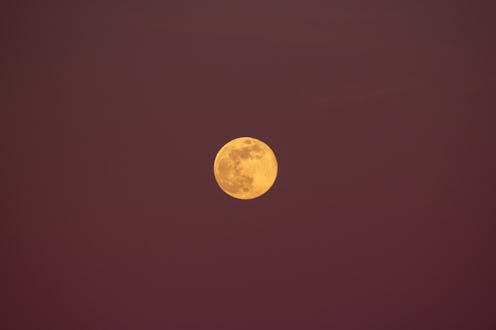Life
Where The "Pink Moon" Got Its Name

If you keep up with the starry-eyed corner of the internet, you've probably heard that April's full moon has an interesting name — one that you'd think would be more appropriate for Valentine's Day. So why is it called the Pink Moon? As awesome (and ever-so-fashionable) as it would be to see a pink disc hanging out in the sky this month, the April full moon's name has nothing to do with the moon's color.
According to the Old Farmer's Almanac, the Pink Moon is named after one of spring's first flowers, wild ground phlox. Also known as moss pink, the brightly-colored flower often blooms around the same time as April's full moon. That's where the "Pink Moon" moniker comes from; however, the moon has also been called the Sprouting Grass Moon, the Egg Moon, and the Fish Moon. This month, the moon will be at its fullest on Tuesday, April 11, at 2:08 a.m. — you know, in case you're watching out for werewolves or something — but you'll still be able to catch a beautiful view of the (normal-colored) moon between April 10 and April 12.
As you've probably guessed, full moon names are derived from characteristics of the month in which they take place. February's moon, for example, is known as the Snow Moon, and July's is the Buck Moon, a reference to the season in which bucks grow new antlers.
According to the Almanac, these names were used to help some Native American peoples keep track of time without using Gregorian or Julian calendars. Cycles varied from culture to culture; some viewed a year as 12 moons, while others defined it as 13. Some lunar calendars added a moon cycle every so often to keep them aligned correctly with the seasons — a "leap moon," so to speak. The names for each moon cycle also differed depending on the culture, which is why most full moons have several different names. Today, however, most people go by what's listed in the Almanac, which uses names from the Alqonquian tribe along the Atlantic Coast and Great Lakes region.
This month, you can also keep an eye out for the Lyrids meteor shower, which peaks on the morning of April 22. The moon will be waning at that point, providing a dark backdrop to catch the falling stars. The new moon will take place a few days later, on April 26, and you can finish out the month by celebrating International Astronomy Day on April 29.
Whether you sleep through the Pink Moon or stay up to catch it at its peak, try not to think about the (thoroughly debunked) superstition that the full moon makes everyone behave a little oddly. Oops — did I remind you?
This article was originally published on